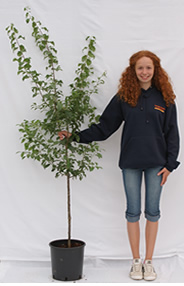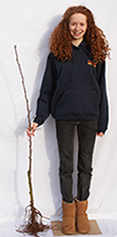We supply fruit trees either as bare-root or container-grown. This page explains some of the differences. However please note that we do not necessarily offer the same variety in both container-grown and bare-root formats.
Pot-grown fruit trees
Pot-grown or container-grown fruit trees are produced by transplanting 1-year field-grown trees into containers. For most species the tree will be grown for the whole of its second year in the container, which produces a well-branched tree ready for the garden. However in the case of some plum and damson trees, which don't suit being grown in containers for too long, we transplant the 1-year field-grown tree for a second summer in the field before putting it in a container in the autumn.
The big advantage of pot-grown trees is that you can order them and plant them out at most times of the year - generally from late summer all the way through to spring - although local weather conditions can interrupt matters. Unlike bare-root trees, you can also leave container-grown trees in their containers for several weeks before finally planting them out (provided you look after them of course), giving you more opportunities to get your garden or orchard plan just right.

Large pot-grown trees will be 2 years old when they are delivered to you and will have received some initial training and pruning to get you started, and to encourage fruit buds to form. This means that they look more impressive than bare-root trees when they are delivered, useful to know if you want to send trees to a friend or relative as a gift. Some might fruit the year after planting (dependent to some extent on the variety) but we recommend you resist temptation and remove any fruit as it forms after the spring blossom, to let the tree establish itself. (It is fine to let 1 or 2 fruits form if you are impatient!).
The photograph shows a 2-year old Damson tree in a 12L container on St. Julien rootstock. The photograph was taken in late summer so the tree still has leaves.
Please note that pot-grown trees are not designed to remain in their containers permanently, and should be planted out in the garden as soon as it is convenient. This is especially important with container-grown plum trees, which should be planted as quickly as possible. Even if you intend to grow the tree on a patio, you must still transfer it to a proper pot or tub.
Bare-root fruit trees
Bare-root fruit trees are grown in open ground in the nursery. There will be no soil around the roots when they are delivered but they are covered with a bag to prevent them drying out. Bare-root trees are very resilient to the rigours of being shipped from the nursery to the customer.

Bare-root trees can only be delivered during the winter when the trees are dormant, usually December - February. It can sometimes be frustrating to have to wait perhaps many months for your fruit trees to arrive, if you are impatient to plant them in a new garden ... but remember that fruit trees only grow during the spring and summer, so you are not losing any time by waiting for them.
Some bare-root trees will be just 1 season old when you receive them, and will have minimal formative pruning. These are known as ""maiden"" trees and are a blank canvas for you to train as you wish. If you want to grow an espalier or fan, then we recommend bare-root rather than container-grown trees for this reason. We also offer many 2-year bare-root trees, and like their container-grown equivalents, these will have the advantage of some initial pruning and training in the nursery.
Once planted bare-root trees generally do not need quite so much attention in their first year as container-grown trees.
The photograph shows a bare-root 1 year apple tree on the M9 rootstock. Bare-root trees are only supplied during winter so do not usually have any leaves. Bare-root trees do look rather unattractive when they arrive, but in a couple of years they will transform themselves into productive fruit trees.
How to choose?
The following table summarises some of the advantages of each format, but don't take this too literally, as the two formats are largely interchangeable.
| Pot-grown trees are best for | Bare-root trees are best for | |
|---|---|---|
|
|
